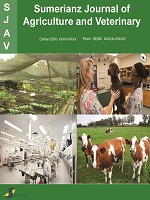Sumerianz Journal of Agriculture and Veterinary

Online ISSN: 2617-3077
Print ISSN: 2617-3131
Quarterly Published (4 Issues Per Year)
Journal Website: https://www.sumerianz.com/?ic=journal-home&journal=30Archive
Volume 3 Issue 5 (2020)
The Susceptibility of Eucalyptus Species Seedlings to Red Gum Lerp Psyllid (Glycapsis Brimblecombei) In Lilongwe Malawi
Authors : Dominic Tembo ; Gift Kamanga Thole ; Edward Missanjo
Abstract:
Red Gum Lerp Psyllid (RGLP), Glycaspis brimblecombei Moore (Hemiptera: Pysllidae) is an insect pest that attacks various Eucalyptus species by causing leaf discolouration, severe leaf drops and twig dieback. Extensive attacks weaken the tree and make it prone to other secondary pests. There is a continued practice of planting different Eucalyptus species without considering whether they are susceptible or not to RGLP attacks. This might hinder the success of afforestation and reforestation programmes. In this study, seven months old, E. camadulensis, E. maidenni, E. tereticornis and E. grandis species tree seedlings at Bunda Forest Reserve tree nursery in Lilongwe, Malawi were tested to determine their susceptibility to RGLP attacks, which part of the leaf is mostly attacked by RGLP and to determine the survival rate of the susceptible Eucalyptus species. The seedlings were exposed to a highly infested Eucalyptus species trees for one month and twenty days. Data was being collected at a ten-day interval. The results indicate that there were significant differences (P<0.05) on Damage Indices (DI) among the Eucalyptus species. E. camadulensis and E. tereticornis were severely susceptible to RGLP with DI of 2.9 and 2.7, respectively. On the other hand, E. grandis and E. maidenni were medium and resistant to RGLP with DI of 1.2 and 0, respectively. There were more RGLP lerps on abaxial part of the leaf surface than on its adaxial part of leaf surface. E. maidenni had the highest survival rate (100%) followed by E. tereticornis (90.5%). Both E. camadulensis and E. grandis had the lowest survival rate (85.7%). Raising of E. maidenni tree seedlings which is resistant to RGLP attacks may promote the successful afforestation and reforestation programmes in Lilongwe, Malawi and areas with similar environmental conditions with Lilongwe.
Isolation and Identification of Fungi Associated With Tomato (Lycopersicon Esculentum M.) ROT
Authors : Yusuf Lamidi ; Agieni G. A. ; Olorunmowaju Abiodun Israel
Abstract:Tomato (Lycopersicon esculentum) is the most popular vegetable worldwide. They have high spoilage rate because of their high moisture content. Many pathogenic fungi are the subject of intense study because they cause disease symptoms that have negative effect on the yield and quality of tomato fruits; they produce mycotoxins that are detrimental to human health. Isolation and identification of fungal organisms causing rot of tomato purchased from Anyigba main market was carried out. Sabouraud Dextrose Agar was used and four fungal species were isolated; Aspergillus spp, Penicillium spp, Rhizopus spp and Fusarium spp. The most frequent being Aspergillus spp (38.89%) and the lowest was Fusarium spp (5.56%). The pathogenicity test carried out implicated these organisms in the spoilage of healthy tomato fruits. Proper handling and adequate storage facilities must therefore be employed to prolong the shelf life of tomato fruits.


